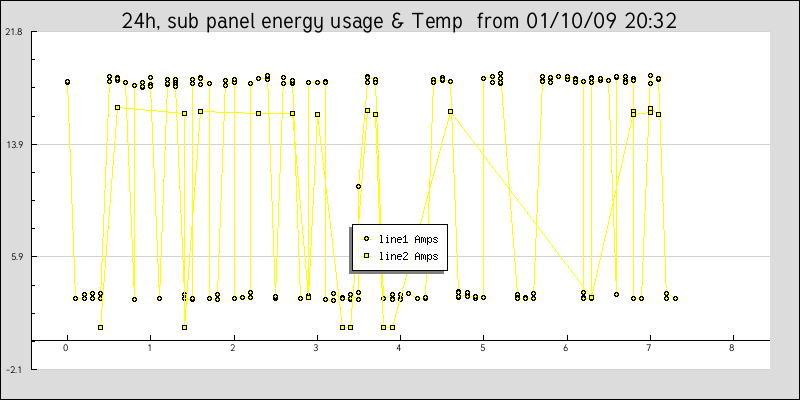- Home
- Deceptions
- Solar
- Thermal Audit
- Ventilation
- Sensors
- Governance
- Environment
- Reference
- Contact
- News
1-wire kWh Monitoring
Household power distribution panels in North America use 220 volt power, delivered as a neutral and a pair of 110 volt lines. The curcuit breaker panels have three vertical bars (line 1, neutral, line2) into which circuit breakers snap onto. 220 volt breakers (these supply the hot water tank, electrical heaters, electric stoves) attached to line1 and line2. 110 volt breakers connect either to line1 and neutral, or line2 and neutral.
When you take the cover off of a panel, as in the one below, you will see some very large wires. The red and black ones below are line1 and line2. If we can measure the current through these two wires, we will be measuring the entire electrical load.
To do this, we need to clamp current transformers onto the lines. The ones shown below are CR magnetics model CR3110-3000 (Digikey part number 582-1004-ND, ) and were supplied with the iButtonLink MS-TC - Temp/Current Sensor . Current transformers like this are hinged, and snap around the wires. The kind that are fixed, often shaped like donuts are better but require you to remove the wires and thread them through the hole in the center of the transformer.
Make sure you cut the power to the panel or that your are completely comfortable with the fact that if your bare hands touch the bus bars, that you risk a most nasty death that will horrify your family.

When you hookup a current transformer and pass current through it, you will generate several volts on the output, and in some cases, enough to get a mild shock. The transformers will also buzz loudy. In order to prevent this, you should connect the output of the transformers (the pairs of small black and white wires above leading from the transformers out through the right hand side of the panel) to the measurement sensor. The sensor unit has a burden resister that is needed to keep the current transformer from damaging itself.
You should check out your local electrical codes to see if the above is ok. I sliped a section of insulation from a piece of Romex over the low voltage current transformer wires to protect it from being mangled by the cable clamp inserted into the knockout at the bottom left of the picture.
If we start collecting data once a minute, we can perform some basic integration and get a reasonably accurate results that will come close to your utility meter. The only active circuits responsible for the data in the graph below are a 220v water heater used in a floor heating system and some 110v circulation pumps and automation electronics. Since line1 in the graph below has both the 110v loads as well as half the 220v load, it is higher and never off completely.

Software:
... work in progress ...
Please check back later for w1retap details and how to calculate/integrate the kWh and comparison to the utility meter reading.
--end--
